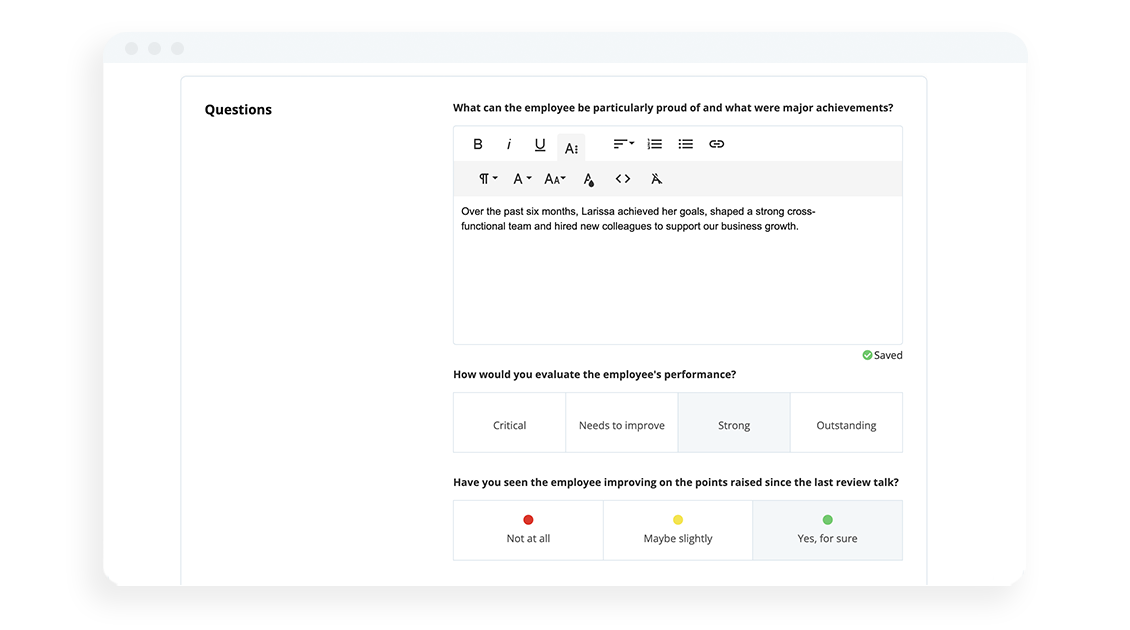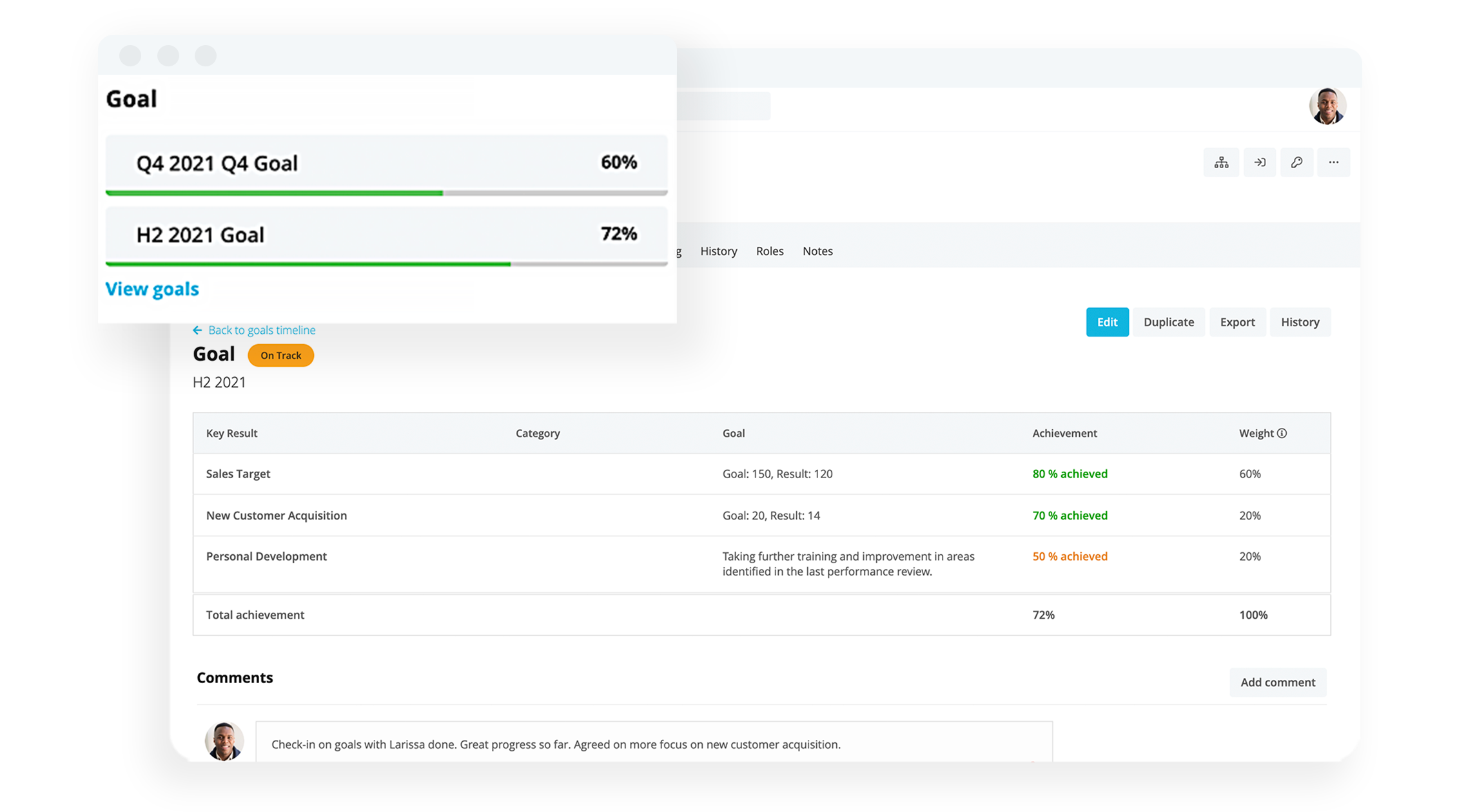A performance improvement plan (PIP) can transform an unpleasant experience into a good one. After all, nobody likes delivering negative employee feedback, but everyone appreciates a plan to improve.
In this article, we break down exactly what goes into one of these plans, why they are so effective, and even offer a free template you can get started with today.
Kick things off by downloading our target agreement template.
Contents
What Is A Performance Improvement Plan?
When Is A Performance Improvement Plan Appropriate?
How Should You Introduce A Performance Improvement Plan
8 Steps To Designing A Performance Improvement Plan
4 Main Benefits Of A Performance Improvement Plan?
What Is A Performance Improvement Plan?
A performance improvement plan, also known as a performance action plan, is a formal document that outlines an employee’s performance deficiencies, along with a timeline and goal-oriented plan to help them improve.
Do Performance Improvement Plans Actually Work?
What makes introducing a performance improvement plan even easier is knowing your employees will likely welcome it. After all, 65% of employees say they actually want more feedback, as long as it’s actionable and constructive.
Almost a quarter of employees have considered leaving their job because their managers provide inadequate feedback, which is why implementing a goal-based performance improvement plan is so important.
When Is A Performance Improvement Plan Appropriate?
Performance improvement plans won’t work for every employee issue.
They’re best suited for situations where an employee is underperforming but has the potential to improve, and when clear and attainable goals can be set for the employee to reach.
Common problems that can be resolved with a performance improvement plan include:
- Poor sales
- Poor quality of work
- Consistent tardiness or absences
- Low productivity and missed deadlines
- Poor client/customer feedback
Issues around behavior or conduct aren’t as well-suited for a performance improvement plan, as it’s harder to set attainable goals for something like insubordination or harassment.
Read more about disciplinary meetings here and verbal warnings here.
There may also be a personal issue that’s affecting the employee’s performance, and not necessarily an issue with their skills or training.
If so, the employee would benefit more from an approved leave or increased mental health support rather than a performance improvement plan.
Is A Performance Improvement Plan A Disciplinary Step?
Not usually, no. A performance improvement plan is not designed to discipline an employee, but to serve as an opportunity for them to get their performance where it needs to be.
That said, it may be a prelude to disciplinary action, but it is not fair to assume that it always would or would require it.
After all, an employee may not have intentionally done something wrong to warrant a PIP. They may simply need help improving in their work, rather than correcting a transgression or personal misconduct.
Focus On Performance Improvement With Personio
Help your employees reach new heights and improve with Personio. Automated performance cycles, self-evaluations, and manager feedback, all in one place. Click the button below to see how it all comes together.
How Should You Introduce A Performance Improvement Plan?
How should an HR professional or leader introduce a PIP to an underperforming employee? Of course, we want to make sure we approach this topic with the right level of care and consideration.
After all, as you can imagine, receiving a PIP can be stressful for an employee. Receiving criticism is uncomfortable, and PIPs have a reputation for being many employer’s last attempt at employee improvement before they let them go.
Employees don’t always lose their job after receiving a PIP, but the thought alone can increase stress. Luckily, as an employer, your approach to the process can change all of that.
Focus On The Positives Of A Performance Improvement Plan
Instead of using a PIP to point out everything an employee is doing wrong, present it as an opportunity for the employee to learn, grow, and achieve their potential, all with the full support of their employer.
This can transform the experience for both parties, taking it from anxiety-inducing to motivational.
Here are 31 other concrete ways to motivate your employees today.
8 Steps To Designing A Performance Improvement Plan
Every performance improvement plan should be highly tailored to the employee, their performance deficiencies, and the goals that will help them improve.
To design an effective PIP for every employee, follow this guide:
1. Evaluate The Situation
While some employers will use PIPs as a way to document employee issues before terminating them, that’s not necessarily their best use.
A performance improvement plan is best used in a situation where an employee needs help improving in their role and performance, has the potential, and is committed to that improvement.
If the employee and their situation fit the criteria, then moving forward with a PIP is likely the best course of action.
If the employee has disengaged completely from their work and role, you as an employer can only do so much.
They may not see their issues as issues and may not be committed to improvement, in which case a verbal warning, demotion, transfer, or termination may be the necessary next step.
Get Insight Into Their Performance
To confirm there’s an issue that warrants a PIP, review the employee’s performance and speak with their superior or team to get insight into their day-to-day conduct.
Create a record of their performance deficiencies and collect documented proof of each. If the employee has received previous warnings related to their performance, review the documents and include those in the file.
Click here to discover document management with Personio.
You may also want to include details on how the employee’s performance has affected their:
- Team
- Project deadlines
- Client/customer relationships
- The company’s overall success
This is not designed to guilt the employee, of course, but to emphasize how valued and important they are to the business.
Finally, look over the employee’s most recent performance review, or multiple reviews, depending on their seniority with the company. This can often shed light on ongoing issues.
3. Manager Review
Employee success is a team effort; if employees haven’t received the support, training, and continuous guidance they need from their manager or supervisor, they haven’t been set up for success.
Review the employee’s training history, onboarding experience, and how they’ve been supported by their manager or supervisor to see if there has been a lack of training or help from leadership.
Next, uncover their supervisor’s expectations and goals. Are they committed to helping this employee succeed, or are they more focused on getting them terminated? Their mindset can have a drastic impact on how successfully the PIP plays out.
This is not an employee vs employer scenario — everyone should be on the same page from the get-go and work together as one team.
4. Get Started: Performance Improvement Plan Template
With the collected information, the employee’s manager or supervisor will create a draft of the performance improvement plan, which is then reviewed by HR.
The document should cover the following:
Background and Basics:
- Employee’s name, title, job description, and responsibilities
- Expectations around employee’s performance levels (sales goals, projects, etc.)
- Record of deficiencies with specific examples, dates, and proof
Clear Goals and Timelines:
- A timeline with scheduled check-in meetings
- Attainable goals set within a realistic timeframe, such as:
- Hitting a certain sales target in one quarter
- No late arrivals or unapproved absences for one month
- No missed deadlines for three months
- Completing tasks at a certain rate
- How the company will support the employee (training courses, mentorship, coaching, etc.)
- Consequences for not meeting the goals of the plan or not completing it
Download Our Performance Review Template
Focus on helping your managers deliver the best possible performance review, alongside a performance improvement plan. Download our performance review template today.
5.HR Review
The HR department will then review the claims and proof to ensure they’re substantiated and are well-suited for a PIP, confirming the following:
- The goals are attainable, relevant, and possible to achieve within the given timeframe.
- There’s no bias against the employee from their manager. (If a manager would rather terminate an employee than conduct a PIP, the document may unfairly overemphasize the issues or faults of the employee.)
- The employee has the tools, support, and guidance they need to achieve the goals.
6. PIP Meeting
The manager, HR representative, and employee will then meet to review the plan and timelines which have been approved by the HR team.
You will want to keep the atmosphere very open and positive during this time, emphasizing that you’re there to encourage and support the employee and help them reach their full potential.
Getting the employee’s input and feedback is key to nurturing a positive environment and approach. Let them ask questions and try to break down any blockers or problems that are presented.
After the meeting, you may need to modify the plan based on the employee’s input (where appropriate). When the plan is complete, it must be signed by both manager and employee and approved by HR.
7. Employee Check-Ins
Once the employee receives the performance improvement plan and reaches the established start date, the ball is mostly in their court.
How long does a PIP last? Typically 30, 60, or 90 days; the timeline should be tailored to an employee’s specific goals and how long it will take to accomplish them.
Schedule check-in meetings with the manager and employee throughout the course of the plan to keep the process running smoothly, and to help the employee get as much from the experience as possible.
Double-check they have all of the tools and training they need as they move forward, and keep the door open to conversation and advice if the employee needs additional support.
8. Plan Completion And Next Steps
At the end of the performance improvement plan, arrange a closing meeting with the employee and manager to review the employee’s progress, see which goals they’ve hit, and clarify next steps.
If the employee hits their goals or finishes training before the official end of their plan, this meeting may get moved up.
Either way, it’s a great time to celebrate all that the employee has accomplished, set expectations for their job performance moving forward, and keep that positive momentum going!
4 Main Benefits Of A Performance Improvement Plan
While the focus of a performance improvement plan is to address and resolve specific issues, its impact is often much greater:
Better Employee Experiences
Employees are more engaged when their managers help them set performance goals, which encourages them to take more pride in their work, produce better results, and increases their overall job satisfaction.
More Skilled Employees
Skill gaps are often the root cause of many workplace performance issues. Whether the employee never received proper training or never developed the skills needed for their role, a performance improvement plan will find those knowledge gaps, identify the training needed to fill them, and help you create an effective training schedule.
In the end, the employee will be better at their job, and you’ll have an even stronger team because of it.
Improved Relationships
Performance improvement plans often pave the way for much-needed conversations to happen, where employees can address difficult issues they may not otherwise come forward with.
When managers and supervisors are more open and approachable, employees are more engaged in their work, and that engagement increases 30% when the feedback they receive is focused on their strengths. Positivity is powerful, isn’t it?
Increased Employee Retention
By emphasizing the positive aspects of a PIP, employees will see that their employers really are supportive of them and want to see them succeed. With the right training, they’ll also gain confidence in their role, which can help keep them motivated and aligned with the company’s mission.
Struggling employees are like diamonds in the rough. But with a performance improvement plan that’s presented and executed with positivity and strategy, they can easily get back on track, improve their work, and shine in their role.
Give Employee
Performance A Boost







